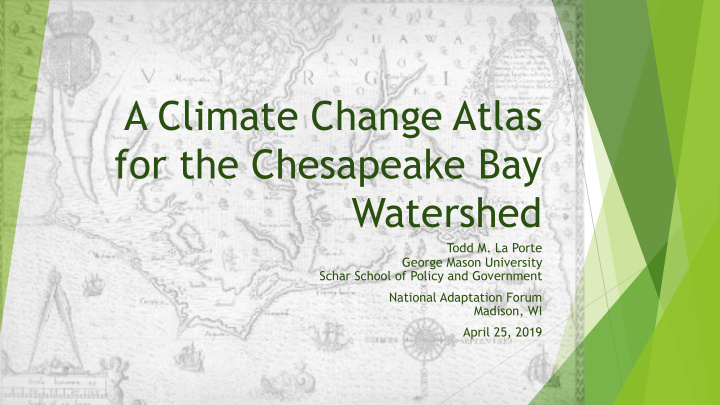



A Climate Change Atlas for the Chesapeake Bay Watershed Todd M. La Porte George Mason University Schar School of Policy and Government National Adaptation Forum Madison, WI April 25, 2019
Why maps and atlases? They are tools for understanding and Maps are the intersection of u u action engineering, science, politics, faith and art They tell stories about where we have u been, where we want to go Atlases provide context for maps, data, u experiences by exploring themes They help explore relationships and They may assist decision-making and u u cross-scale perspectives: zoom in and reconcile conflict over intractable or out wicked problems They help explore simultaneities, u interdependencies We find the world in maps u Display dominant and (less often) We find ourselves in maps u u alternative values including IEK, EJ, We find God in maps u PGIS
Why watersheds? Why Chesapeake Bay? Watersheds often have pre-existing institutional governance u arrangements Traditional political boundaries often arbitrary, political u compromises … … make managing ecosystems administratively and politically u more complex Chesapeake Bay is largest is United States u Complex governance arrangements: 6 states and DC, u Federal Gov’t, counties, cities, towns, regional entities Goldilocks size captures regional scale effectively: not too u small, not too big Long-standing pollution control problem > institutional and u policy responses, but little climate change policy development Good case to test concept u
What might such an atlas look like? Traditional book pushing the boundaries of the medium u Beautiful and compelling u Subversive but useful u Open and participatory: doesn’t lead but enables u We need to see ourselves in the maps we make and questions we ask of them: u histories, identities and cultures matter We need to recognize whose interests and needs are reflected and whose u aren’t We need to recognize inherent contingency, and ask “Did we get it right?” u
What might it contain? u 5 th order: Administrative effects: I. Climate Past u risk management, taxation, finance, u History, livelihoods public health, social welfare u Culture, identity u Incorporate indigenous ecological knowledge (IEK), novel values: II. Climate Present u Sacred places? Synthetic values? u GIS platform and traditional u Illustrate interdependence, cartography simultaneity, complexity u 1 st order: Climate change: temperature, precipitation, SLR u 2 nd order: Biological effects: flora/fauna, forests, rivers, oceans u 3 rd order: Economic effects: agriculture, industry, infrastructure, property u 4 th order: Social effects: population movements, health, justice, disasters
III. Climate Future(s)? New ways of seeing and working u u Unconventional conceptions of climate change and responses, u Climate art u Radical mapping u Adaptation design, e.g. MOMA, SF BCDC u Atlas as platform for participatory GIS (PGIS) public engagement processes
Could it work? Examples Climate atlases: world, nation, regions, cities u Environmental and biodiversity atlases u Historical ecology atlases: Napa u Thematic atlases: Bayer World Geo-graphic Atlas u Beautiful atlases: Times Atlas of the World; California Field Atlas u Radical, post-modern, strange, imaginary maps u
Could it work? Book, GIS Traditional book format u u Useful for collaboration, non-screen and tactile-oriented users u Innovative textual approaches: overlays, cutouts, novel printing techniques GIS platform u u Essential to assemble and manage data, produce maps u Useful for research, data analysis, teaching: student use of datasets u Perfect not the enemy of the good: rendering science as useable knowledge
Could it work? Public engagement Public engagement u u Distribute atlas widely: beta version, attractive but “draft” u Create a network of conveners around watershed: collaboration entities, universities, adaptation forum, NGOs u Convene local ground-truthing feedback sessions: do the researchers get it right? What do they miss? u Simultaneously offer to assist stakeholders to articulate or assist with their issues
Who is needed? What is needed? Interdisciplinary teams of students and experts u u Environmental history u Rural sociology and anthropology u Climate and ecology sciences u Climate adaptation u Environmental and public policy u Environmental conflict resolution and public engagement u Geography and cartography u Art and design Data management, GIS analysis and map creation, web design u Partners in region u Funding u
Recommend
More recommend